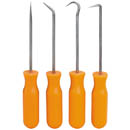- Joined
- Apr 22, 2013
- Messages
- 1,023
- Reaction score
- 9
- Location
- san diego
- My Car
- 1973 mustang convertible(some day)
So I paid an upholstery guy to do my front seat covers after I dismantled and painted the frames . The job came out loose and they blamed it on the poor fitment of the TMI foam and covers. Knowing I wouldn't be satisfied I dismantled then and found that the didn't attach the listing wire to the frame and didn't add any extra padding to tighten things up. I tried several times to get the hog rings to catch both the listing wire and the frame but couldn't get through all the materials. I remembered a thread on the site that recommended wire ties but still struggled those until I started using a surgical clamp to thread them. Once I tightened the wire ties it was very easy to get the hog rings to catch. The threading and wire ties made the install a snap. In hind side the front seat cover install was very easy once you figure out a few things:
1. Heat seat covers in the sun and covers become very pliable.
2. Wire tie listing wires first and fine tune adjustment. Where the listing wire goes in the seat consider slicing it where the wire tie/hog ring connects so it can slide up or down on the wire for adjusting the seat cover on the foam. Where my thumb is.
3. Add padding to fill loose areas


1. Heat seat covers in the sun and covers become very pliable.
2. Wire tie listing wires first and fine tune adjustment. Where the listing wire goes in the seat consider slicing it where the wire tie/hog ring connects so it can slide up or down on the wire for adjusting the seat cover on the foam. Where my thumb is.
3. Add padding to fill loose areas


Last edited by a moderator:





















































